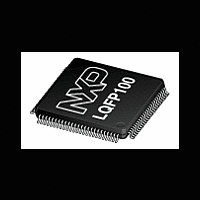LPC2361_62 NXP Semiconductors, LPC2361_62 Datasheet - Page 13

LPC2361_62
Manufacturer Part Number
LPC2361_62
Description
The LPC2361/2362 microcontrollers are based on a 16-bit/32-bit ARM7TDMI-S CPU with real-time emulation that combines the microcontroller with up to 128 kB of embedded high-speed flash memory
Manufacturer
NXP Semiconductors
Datasheet
1.LPC2361_62.pdf
(64 pages)
NXP Semiconductors
[3]
[4]
[5]
[6]
[7]
[8]
[9]
[10] Pad provides special analog functionality.
[11] When the main oscillator is not used, connect XTAL1 and XTAL2 as follows: XTAL1 can be left floating or can be grounded (grounding
[12] If the RTC is not used, these pins can be left floating.
[13] Pad provides special analog functionality.
[14] Pad provides special analog functionality.
[15] Pad provides special analog functionality.
[16] Pad provides special analog functionality.
[17] Pad provides special analog functionality.
7. Functional description
LPC2361_62
Product data sheet
5 V tolerant pad providing digital I/O with TTL levels and hysteresis and analog output function. When configured as the DAC output,
digital section of the pad is disabled.
Open-drain 5 V tolerant digital I/O pad, compatible with I
output functionality. When power is switched off, this pin connected to the I
Open-drain configuration applies to all functions on this pin.
Pad provides digital I/O and USB functions. It is designed in accordance with the USB specification, revision 2.0 (Full-speed and
Low-speed mode only).
5 V tolerant pad with 5 ns glitch filter providing digital I/O functions with TTL levels and hysteresis.
This pin has no built-in pull-up and no built-in pull-down resistor.
This pin has a built-in pull-up resistor.
5 V tolerant pad with 20 ns glitch filter providing digital I/O function with TTL levels and hysteresis.
is preferred to reduce susceptibility to noise). XTAL2 should be left floating.
7.1 Architectural overview
The LPC2361/2362 microcontroller consists of an ARM7TDMI-S CPU with emulation
support, the ARM7 local bus for closely coupled, high-speed access to the majority of
on-chip memory, the AMBA AHB interfacing to high-speed on-chip peripherals, and the
AMBA APB for connection to other on-chip peripheral functions. The microcontroller
permanently configures the ARM7TDMI-S processor for little-endian byte order.
The LPC2362 implements two AHBs in order to allow the Ethernet block to operate
without interference caused by other system activity. The primary AHB, referred to as
AHB1, includes the VIC and GPDMA controller.
The second AHB, referred to as AHB2, includes only the Ethernet block and an
associated 16 kB SRAM. In addition, a bus bridge is provided that allows the secondary
AHB to be a bus master on AHB1, allowing expansion of Ethernet buffer space into
off-chip memory or unused space in memory residing on AHB1.
In summary, bus masters with access to AHB1 are the ARM7 itself, the GPDMA function,
and the Ethernet block (via the bus bridge from AHB2). Bus masters with access to AHB2
are the ARM7 and the Ethernet block.
AHB peripherals are allocated a 2 MB range of addresses at the very top of the 4 GB
ARM memory space. Each AHB peripheral is allocated a 16 kB address space within the
AHB address space. Lower speed peripheral functions are connected to the APB. The
AHB to APB bridge interfaces the APB to the AHB. APB peripherals are also allocated a
2 MB range of addresses, beginning at the 3.5 GB address point. Each APB peripheral is
allocated a 16 kB address space within the APB address space.
All information provided in this document is subject to legal disclaimers.
Rev. 5 — 25 October 2011
2
C-bus 400 kHz specification. This pad requires an external pull-up to provide
2
C-bus is floating and does not disturb the I
Single-chip 16-bit/32-bit MCU
LPC2361/62
© NXP B.V. 2011. All rights reserved.
2
C lines.
13 of 64














